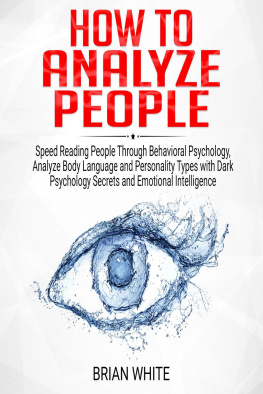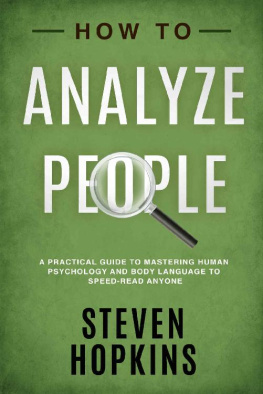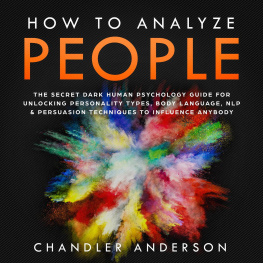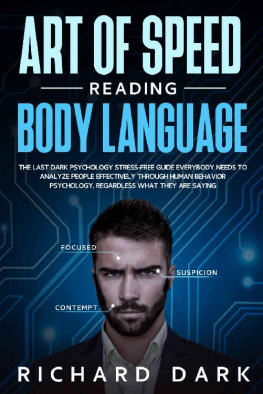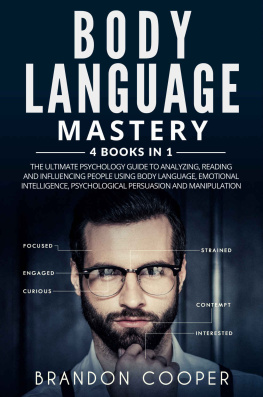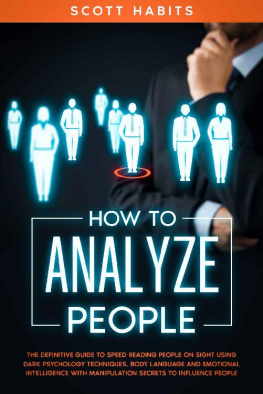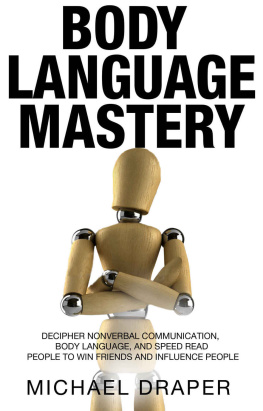Body Language
Mastery
4 BOOKS IN 1
The Ultimate Psychology Guide to Analyzing, Reading and Influencing People Using Body Language, Emotional Intelligence, Psychological Persuasion and Manipulation
Brandon Cooper
Copyright 2019 by Brandon Cooper- All rights reserved.
This document is geared towards providing exact and reliable information regarding topic and issue covered. The publication is sold with the idea that the publisher is not required to render accounting, officially permitted, or otherwise, qualified services. If advice is necessary, legal or professional, a practiced individual in the profession should be ordered.
- From a Declaration of Principles which was accepted and approved equally by a Committee of the American Bar Association and a Committee of Publishers and Associations.
In no way is it legal to reproduce, duplicate, or transmit any part of this document in either electronic means or in printed format. Recording of this publication is strictly prohibited and any storage of this document is not allowed unless with written permission from the publisher. All rights reserved.
The information provided herein is stated to be truthful and consistent, in that any liability, in terms of inattention or otherwise, by any usage or abuse of any policies, processes, or directions contained within is the solitary and utter responsibility of the recipient reader. Under no circumstances will any legal responsibility or blame be held against the publisher for any reparation, damages, or monetary loss due to the information herein, either directly or indirectly.
Respective authors own all copyrights not held by the publisher.
The information herein is offered for informational purposes solely, and is universal as so. The presentation of the information is without contract or any type of guarantee assurance.
The trademarks that are used are without any consent, and the publication of the trademark is without permission or backing by the trademark owner. All trademarks and brands within this book are for clarifying purposes only and are the owned by the owners themselves, not affiliated with this document.
How to Analyze People
T he Complete Psychologists Guide to Speed Reading People Analyze and Influence Anyone through Human Behavior Psychology, Analysis of Body Language and Personality Types
Table of Contents
Introduction
Congratulations on getting a copy of How to Analyze People: The Complete Psychologists Guide to Speed Reading People Analyze and Influence Anyone through Human Behavior Psychology, Analysis of Body Language and Personality Type.
Body language can be likened to secret windows of the soul. Since our emotions are intertwined with our behavior, our inner feelings can appear through subtle body movements. Many of these slight changes are so innate, you may not even realize they are happening. Certain emotions like fear, lust, and euphoria can be detected through the manner in which a person moves the body. Many of these expressions are innate and are primal instincts. Much like a baby grasping the finger of his mother, he instinctively is communicating through movement.
One may conclude that understanding body language is a useless skill because we have the gift of verbal communication. While the art of linguistics is certainly necessary to communication, oftentimes, words only tell a small truth. People who lack the proper understanding of the connection between the body and mind will miss these slight signals. For example, the slight curve of the lips combined with a forward lean speaks attraction even if the words being spoken reveal the opposite. Imagine having the ability to detect when someone was lying by observing a simple eye movement.
There is a dynamic structure of the brain called the limbic system that is responsible for controlling how our emotions translate throughout our bodies. The limbic system controls our inner qualities such as the ability to nurture, express empathy, and even react to love. When your face suddenly blushes because you see your crush, that is your brain responding to the emotion of attraction. Without the limbic system, it would be increasingly difficult to be able to openly express our emotions through physical contact.
Animals Use Body Language to Communicate
Dogs are classic examples of animals who rely heavily on body movements to express themselves. Since they cannot verbalize their emotions to humans, they use their ears, paws, and even their tails to signal important symbols. Universally, a dog's tail wagging has been accepted as a dog showing his friendliness. However, not every wag is welcoming. A stiff, low wagging tail can indicate feelings of uneasiness. A straight, pointed wag is a sign of impending attack. Someone who generalizes all tail wagging as welcoming may encounter an unpleasant situation without the proper knowledge. Dog trainers initially begin their training with body movements to assign meanings to commands.
The same mentality rings true with humans. Many people may say one thing to appease the person they are around, yet their true intentions are masked. By understanding the psychology behind body language, you will be able to actually read people without them even knowing it. This ability comes in handy for the following situations:
- Raising a child
- Understanding your mate's true feelings
- Detecting lies or deception
- Spotting insecurity
- Emergency situations
Once mastered, you will be able to further develop your analytical skills and hone in on your ability to decode human behavior.
When raising young children, the ability to effectively communicate needs doesnt become apparent until around 15 months. Babies and toddlers rely heavily on certain nonverbal cues when communicating their needs. For example, children who experience inner conflict and lack the ability to express themselves verbally may bite their parents or peers as a means to seek attention. This oral fixation is their way of getting their needs met. It is important for parents to understand the subtle movements of others in order to accurately meet the needs of their children.
Humans have used body language as a means of communication since the dawn of time. Before the traditional linguistic structure that we see today was developed, our ancestors relied heavily on innate body movements to express true emotions. In 1872, evolutionist Charles Darwin studied the behavior of humans and animals in his book, The Expression of the Emotions in Man and Animals . He analyzed carefully how animals communicate non-verbally and made scientific comparisons to humans. Without his groundbreaking revelations, different forms of education like anthropology, social sciences, and even kinesics would be irrelevant. As more psychological evidence has appeared, thus proving the existence of legitimate body cues, we have the ability to assign meanings to intricate expressions.
There are plenty of books on this subject on the market. Thanks again for choosing this one, please enjoy!
Chapter 1: Mastering the Art of Analyzing People - Body Language 101
Body Language Clues: The Basics
When individuals communicate, the face is typically the focal point. The lips are home to revealing contextual clues towards a persons thoughts. For example, when the lips begin to draw inward towards the mouth, a person may be hiding something. They may have a secret or detail they want to share with you, but are apprehensive due to various reasons. This is sometimes known as lip swallowing as a person is physically stopping themselves from revealing what they truly want to say.
Many attribute a sad face with the corners of the lips pointing downward. Some individuals rest their lips in this position on a regular basis. This could indicate an inward turmoil or grief they are experiencing. Many of us encounter melancholy individuals whether personally or in the workplace. The next time you are speaking to them, pay attention to the positioning of their lips. You may have a solid backing for viewing them as being generally sad.
Next page

